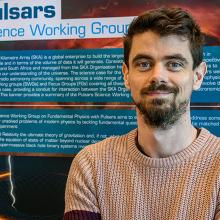
Cherry Ng is a post-doctoral researcher at the Dunlap Institute for Astronomy & Astrophysics. During her PhD study, she has discovered 60 rapidly spinning neutron stars with the Parkes Radio Telescope in Australia. Her hunting effort continues, now with the Canadian CHIME telescope. Together with the team, she uses CHIME to detect and study “fast radio bursts,” a new astrophysical mystery that involves short bursts of radio waves that have come from far outside our Milky Way galaxy.

Evan Keane is an award-winning astrophysicist working in the area of time-domain radio astronomy. Time variable astrophysical signals arise from extreme physical environments, impossible to create in an Earth-bound laboratory, and so offer unique insights into laws of nature. His work involves searching for pulsars and fast radio bursts and using these as tools to understand the Universe. Recently he has begun working on SETI search systems. Since 2015 he has been Project Scientist for the Square Kilometre Array, which commences construction in 2021. Evan's role has been to ensure that the telescope designs can deliver scientifically in time-domain science.
